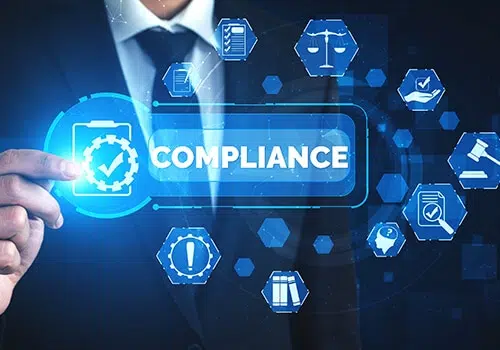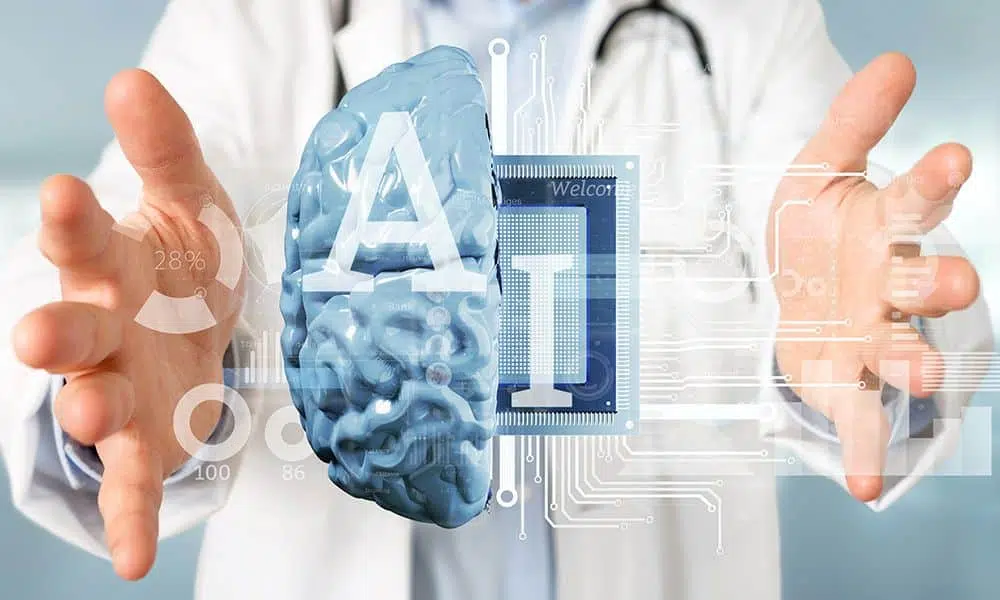Don’t expect to be treated by a robotic physician the next time you visit the doctor’s office. Computers and algorithms might tell us what to watch, what to buy, and who to add to our social networks, but research suggests that healthcare AI won’t be replacing human caregivers anytime soon.
It might, however, help replace confusing paperwork, extended wait times, incorrect diagnoses, and other undesirable elements of the healthcare experience with more favorable ones. AI might also help human physicians scale their practices to treat more patients and empower them to provide more personalized, effective care to individual patients.
Yes, even in 2021, conversations about AI and automation in healthcare tend to focus on potential, promise, and possibilities. After all, most of the opportunities for AI-powered applications in the space are still ahead — mainly because major hurdles must still be overcome in order to clear the way for widespread adoption in the space. Until that happens, this transformative technology will continue to be discussed in terms of what could be (rather than what is).
At Shaip, we want to change the conversation by helping AI development teams overcome these hurdles. We love talking about what the future could hold for healthcare AI, but we love creating that future even more. Before diving into how we do that, though, let’s take a moment to focus on the present.
AI isn’t just poised to change healthcare forever; it already has. While still relatively new, the technology has permeated almost every aspect of the modern-day healthcare system:
- In clinical settings, physicians are using AI-assisted imaging tools with advanced pattern-recognition capabilities to examine the results of CT scans, MRIs, and other types of visual analyses, allowing them to more quickly and accurately detect disease and diagnose injury.
- In the classroom, machine learning tools are helping students gather deeper insights about the human body than ever before and giving them the power to build new solutions with real-world applications.
- In the lab, researchers are harnessing sophisticated programs to cross-reference new drug formulas with medications that are already known to be safe. They can then replicate and iterate on these to develop antidotes and vaccines in record time.
- Administrators and executives are using AI applications to create more intuitive, efficient patient experiences that simultaneously drive revenue for providers and ensure higher-quality care for patients. The list goes on and on.
Because you’re reading this, you probably already realize that AI’s impact on our healthcare system has been massive — and it will only get bigger. Given the countless diverse actors that comprise the sector, the number of challenges that AI solutions can potentially address is seemingly infinite.
Shaip is here to help bring these solutions to life. Our services enable businesses and entrepreneurs to build transformative healthcare AI technologies that can solve real-world problems at scale by eliminating some of the largest hurdles in their way. And for teams working in the healthcare space, there are plenty of those.
Roadblocks and Red Flags
While the promise of AI in healthcare has never been greater, truly integrating the technology into the monolithic healthcare system will be a process filled with hurdles. Perhaps none is more significant than the regulatory obstacles that distinguish medicine from other industries in which adoption has occurred faster.
It’s been nearly a quarter-century since Congress enacted the Health Insurance Portability and Accountability Act (HIPAA), but that same legislation still governs how providers handle patient data in 2021. Unfortunately, it increasingly presents more questions than answers for doctors, patients, and entrepreneurs seeking to build new medical technologies. Moreover, HIPAA mandates are now converging with more recent regulations on personally identifiable information (PII) like the European Union’s General Data Protection Regulation (GDPR), Singapore’s Personal Data Protection Act (PDPA), and the California Consumer Privacy Act (CCPA) that represents the first comprehensive legislation governing data use here in the United States.
The surge in telehealth requirements that accompanied the COVID-19 pandemic has only added more regulatory headaches. For starters, many patients receive remote treatment via platforms that do not meet HIPAA standards, which could leave them vulnerable to privacy threats. Even platforms that are compliant pose risks, as they could disclose sensitive patient information for profit. The growth in demand for virtual care has given rise to many digital services that fall outside of HIPAA’s original scope, and it has compelled big tech companies Facebook, Alphabet, Amazon, and Microsoft to venture into the market, bringing new innovation as well as the need for additional oversight.
For regulators, enforcing compliance within this complex system of mandates is increasingly difficult, as data is being used in new ways and by a growing number of actors. Likewise, for teams hoping to build and deploy AI-powered technologies in the healthcare space, ensuring that these tools meet existing standards requires regulatory expertise that is quite simply hard to find.
Also difficult to find? High-quality medical data. Regulation might keep some new technologies from achieving widespread adoption, but without quality data, AI-powered tools won’t even make it past the development stage.
A recent study published in the Journal of the American Medical Association found that the geographic distribution of patients whose data is used to train machine learning algorithms is mostly limited to a few states, specifically California, New York, and Massachusetts. Given the economic, social, behavioral and other attributes that these patients might share with one another but not the rest of the country, algorithms trained on this data could generalize poorly. This problem could be solved with more diverse data sets, but again, data is hard to acquire. Once acquired, it’s also hard to organize, which is another critical step for developers of machine-learning technologies.
Many companies make significant investments to find or create data for their algorithms and then spend even more paying annotators to label it. As with overly homogenous data sets, data that’s not properly labeled and curated will train AI programs to generate biased and inaccurate results, creating problems that can’t easily be fixed. Unfortunately, these problems will continue to be commonplace for teams working on healthcare AI technology. Research from Gartner reveals that up to 85% of AI projects will yield erroneous outcomes as a result of data-management bias through 2022.
Again, there are plenty of other challenges to creating AI applications for healthcare, both known and unknown. As more developers enter the space and more providers are confronted with decisions about whether to add AI-powered solutions to their strategies for treating patients, these challenges loom large. While obstacles are inevitable when you’re attempting to build useful, transformative tools using new technologies, Shaip helps teams overcome many of the largest hurdles that developers in the space are currently facing.
How Shaip Powers Healthcare AI Progress
Shaip offers a suite of solutions designed specifically for teams working on healthcare AI applications. Together, they can help you realize a significant and multifaceted return on your investment and build scalable products that make a truly lasting impact on the industry.
Fully Managed Data Collection
In order to build applications that can truly be useful to healthcare organizations, teams must build solutions that consistently generate accurate, unbiased outcomes. Sure, you might hear about AI technologies accurately detecting and diagnosing diseases, but this typically happens in scenarios where artificial constraints are used to control for known training limitations, such as a lack of relevant, quality data. If you hope to develop a product that achieves widespread adoption in real clinical settings, it must be able to deliver optimal results under a wide range of high-stakes circumstances. In other words, you’ll need a lot of world-class, reliable data to train your algorithms.
Shaip’s fully managed data collection services ensure you have the data you need when you need it. With our proprietary mobile app, patented web-based platform, and experienced in-house project teams, we’re able to source data from almost any combination of age groups, demographics, and educational backgrounds. Our humans-in-the-loop collection process incorporates subject matter experts from within the healthcare field to ensure that the data you receive meets the highest standards for quality and reliability. In addition to identifying, profiling, and sourcing data, we also take care of data cleansing and preparation, allowing your team to focus on other high-impact activities.
Multiple Data Formats
We can deliver a diverse data set that includes images, video, audio, and text to power a wide range of AI models.
Text:
Shaip has hundreds of experienced professionals available to conduct data annotation on virtually any type of text data, from physician notes to insurance claims, giving you the ability to uncover insights that would otherwise remain hidden in unstructured data sets. Additionally, our intuitive, customizable cloud platform enables you to tailor annotations for highly specific use cases and get domain-specific insights to inform technology development.
Audio:
Shaip has a proven track record of building and optimizing highly functional conversational AI, chatbots, and voice-bots. Thanks to our worldwide network of qualified linguists and a team capable of collecting and annotating volumes of audio data —including unscripted conversations between doctors and patients, utterances and wake-up words, monologues, and other types of speech — we can help you train speech-enabled applications quickly and effectively.
Image:
Our image training data sets are analyzed using a combination of surgically precise manual processes and state-of-the-art technology for applications that depend on sophisticated computer-vision and pattern-recognition capabilities. And we don’t just provide the data; we can also help you develop world-class machine learning algorithms to power solutions that can recognize human faces, food, documents, medical lab images, geospatial images, and other visual information.
Video:
Our people, experience, and technology allow us to fulfill virtually any video annotation requirement. What we do best is object tracking: Annotating videos frame by frame to teach computers to recognize specific objects through machine learning. Whether you’re building AI-enabled robotic equipment to assist physicians in clinical settings or applications that enhance interactions between patients and nurses during telehealth appointments, we can help.
Assurance of Compliance

Shaip offers licensed healthcare data to ease this burden for teams developing AI models that analyze text-based patient medical records, images from CT scans, X-rays (and other visual diagnostics), physician recordings, and dozens of other data types. With Shaip APIs, you get on-demand access to this growing library of de-identified records and quality contextualized medical data (including more than 10 million data sets sourced from more than 60 diverse locations around the globe) that meet all HIPAA and Safe Harbor standards (including the redaction of all 18 identifiers covered in these guidelines). For teams that need more comprehensive services, we can scale data de-identification across multiple regulatory jurisdictions.
As an industry leader in data de-identification, data masking, and data anonymization, patient privacy is at the core of our solutions. We provide expert certification and auditing of de-identification quality and abide by comprehensive personal health information (PHI) annotation guidelines in adherence with Safe Harbor standards. Similarly, the ShaipCloud platform allows you to access your data in a secure environment, further reducing the risk of noncompliance.
Let’s Move Forward Together
At Shaip, we understand AI’s immense potential to improve virtually every aspect of the existing healthcare system, and we’re excited to lend our expertise to the organizations working to unlock that potential. We’re also deeply familiar with the unique challenges these organizations face, and all of our services are designed with these challenges in mind.
If you’re part of a team working on healthcare solutions powered by AI and machine learning technologies, we’d love to help you move your initiative forward. Our experience spans the entire AI development life cycle, and we’ve worked on projects of nearly every scope — we have yet to encounter one that was too big or too small. If you need more information, get in touch today.




